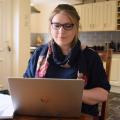
It was during the depths of winter in 1985 when severe weather unearthed the remains of a lost coastal village on a north Norfolk beach.
The following year, geologist and local historian David Stannard happened upon the ruins of Eccles-on-Sea and its 12th-century church, St Mary’s, during a particularly low tide.
The result of this serendipitous walk began a long-lasting research project into the history of the lost village and became an abiding subject for the rest of Mr Stannard’s life.

Previously a geologist in the offshore industry and lecturer at City College Norwich, he had become an amateur archaeologist, author, and historian.
And in freezing conditions, he embarked on snowy excavations on the foreshore while forging an enduring friendship with Ronnie Pestell and his son Tim.
The finds included exposed foundations, cart tracks in clay, Roman pottery, skeletons in graves, and a number of abandoned wells.
The ruins have not been seen since about 2000 and the tower of St Mary’s has been lost once more, now resting 30ft below the sand.

David George Stannard was born in Onley Street, Norwich, on August 16, 1950, and joined his older sister, Christine.
He attended Avenue Road Primary School and then the City of Norwich Grammar School.
As a young boy, he became a keen sea scout alongside his scoutmaster, Stalham pharmacist David Coleman.
After completing his A-Levels, he began training at Bedford College in Regent's Park, London, to become a geological technician.
He qualified in 1971 and attended Queen Mary College at the University of London to study geology. He graduated in 1974.
For the next six years, he lived in a scout house, a grand Queen Anne building, overlooking the Stepney Green gardens.

On leaving Queen Mary College, he travelled to Oklahoma and Houston in the United States to train as an oil rig geologist and thence to the Far East via Singapore.
He worked in Taiwan and the East China Sea for two years, before working in the Red Sea and Gulf of Suez, Iran, the Niger Delta, and the Ivory Coast. He was based in both Athens and Cairo for a considerable time.
Mr Stannard met his future wife, Rosamond, at university and they married on St David's Day in 1979.
Mr Stannard managed an office in Abu Dhabi in the 1980s where the couple moved to for two years. Following the 1985 recession the couple returned to Norfolk.

Mr Stannard worked as an industrial liaison officer with Great Yarmouth Borough Council, a move that kickstarted a career in local government.
Mrs Stannard described this being a time of “great enjoyment”.
She said: “He enjoyed every minute of his work within the economic development department and was part of a happy, busy, dynamic team promoting the borough.”
He eventually moved to Norfolk County Hall as European officer and, following that, he studied at City College Norwich for a PGCE, going on to teach business studies.

Even before the Eccles discovery, Mr Stannard was fascinated by local history.
He became proficient in reading medieval English documents and translated all of the available local wills and documents held by the Norfolk Record Office.
He became a trustee of Norfolk Archives and Heritage Development (Norah) and gave numerous talks to local groups.
Mr Stannard also enjoyed living by the sea and would participate in shrimping and herring fishing.

Mrs Stannard added: "He enjoyed life and lived it well.
“He was a once seen, never forgotten character, but a kind and thoughtful man and a superb communicator who will be sorely missed.”
Mr Stannard died at home from a brain tumour on March 18 with his family beside him. He was aged 71.
A celebration of his life will take place at 2pm on Friday, May 6 at St Andrew's Church in Hempstead. No black clothing to be worn.
Donations to the Norfolk Archives and Heritage Development Foundation via enquiries@norah-df.org.uk as it was a cause close to his heart.
- To pay tribute to a loved one, email norfolktributes@archant.co.uk
- To read more obituaries and tributes join the Facebook group Norfolk's Loved & Lost.





Comments: Our rules
We want our comments to be a lively and valuable part of our community - a place where readers can debate and engage with the most important local issues. The ability to comment on our stories is a privilege, not a right, however, and that privilege may be withdrawn if it is abused or misused.
Please report any comments that break our rules.
Read the rules here